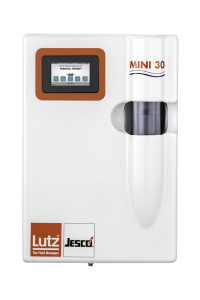Lutz-Jesco Electrolysis System Produces Sodium Hypochlorite from Commercially-Available Salt

The Lutz-Jesco MINICHLORGEN electrolysis system produces sodium hypochlorite from commercially-available salt. (Image source: Lutz-Jesco GmbH)
The system deployed in a range of contexts, including mobile waterworks in Ukrainian war zones, will be on display at Achema 2024, the internationally leading trade fair of the process industry held in Frankfurt am Main between 10 and 14 June 2024.
MINICHLORGEN Skid I can be made ready for use in a short space of time. Lutz-Jesco supplies all the system components including the electrolysis unit, salt dissolving container and chlorine tank – fully wired and mounted on a plastic frame. The system works in the following manner: The user places commercially available salt tablets in a 30 kg container and switches the system on. The system produces salt water with a salt content of between two and three per cent. The water flows past titanium anodes and cathodes in a pipe. The electrolysis current causes chlorine gas and hydrogen gas to form at the electrodes. The subsequent reaction produces a sodium hypochlorite solution with a concentration of between 0.5 and 0.7 per cent. The solution can then be fed by a dosing pump directly into the disinfection process via an injection nozzle – for example for treatment of drinking water.
"MINICHLORGEN Skid I enables particularly safe chlorine handling. Staff never come into contact with the chemical, only with harmless salt,” says Steffen Roth, Head of Development at Lutz-Jesco GmbH. Additional safety is provided by a hydrogen detector, which detects hydrogen in the surrounding air following a leak and triggers an alarm. "This high level of safety makes the electrolysis system interesting not only for the process industry, but also for the operators of swimming pools, spas and wellness centres.”
The electrolysis system generates up to 15 litres of disinfectant per hour
MINICHLORGEN Skid I is available in three performance classes. The devices produce 30, 60 and 90 grammes of chlorine per hour, which corresponds to some 5, 10 and 15 litres of sodium hypochlorite solution with a concentration of 0.6 percent. If the user does not wish to add the liquid directly to the process, it can be stored in a 30-litre tank. This is where the sodium hypochlorite produced by MINICHLORGEN Skid I plays another trump card. “The chlorine content remains stable for months – even without additives,” says Roth. “Commercially available sodium hypochlorite on the other hand, loses up to 20 per cent of its active chlorine content during storage.” Moreover, the sodium hypochlorite solution produced has a very low mineral content. This eliminates the extensive cleaning and descaling of injection nozzles.
Used in Ukrainian waterworks
Lutz-Jesco electrolysis systems are deployed in mobile waterworks in Ukraine. The war has led to the destruction of much core infrastructure in regions such as Kherson, Zaporizhzhia and Marhanets, leading to critical water shortages. With a treatment capacity of 300 cubic metres per hour, the fully automated mobile waterworks can supply some 300,000 people with clean and safe water. “As a key player in the water industry, we are committed to doing our best to improve the water supply throughout the world. As such, we see it as our social obligation to support emergency aid projects in crisis zones through the provision of state-of-the-art technology,” says Heinz Lutz, CEO of Lutz Holding GmbH.
Source: Lutz-Jesco GmbH







